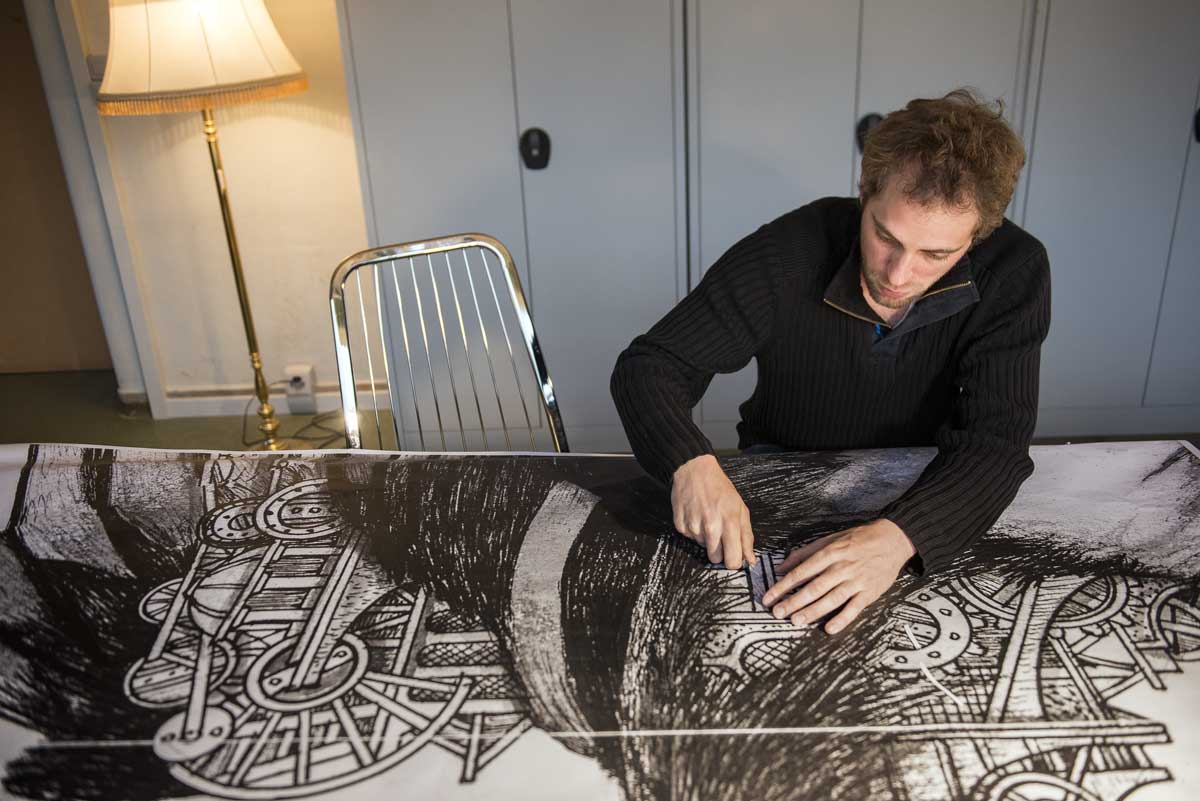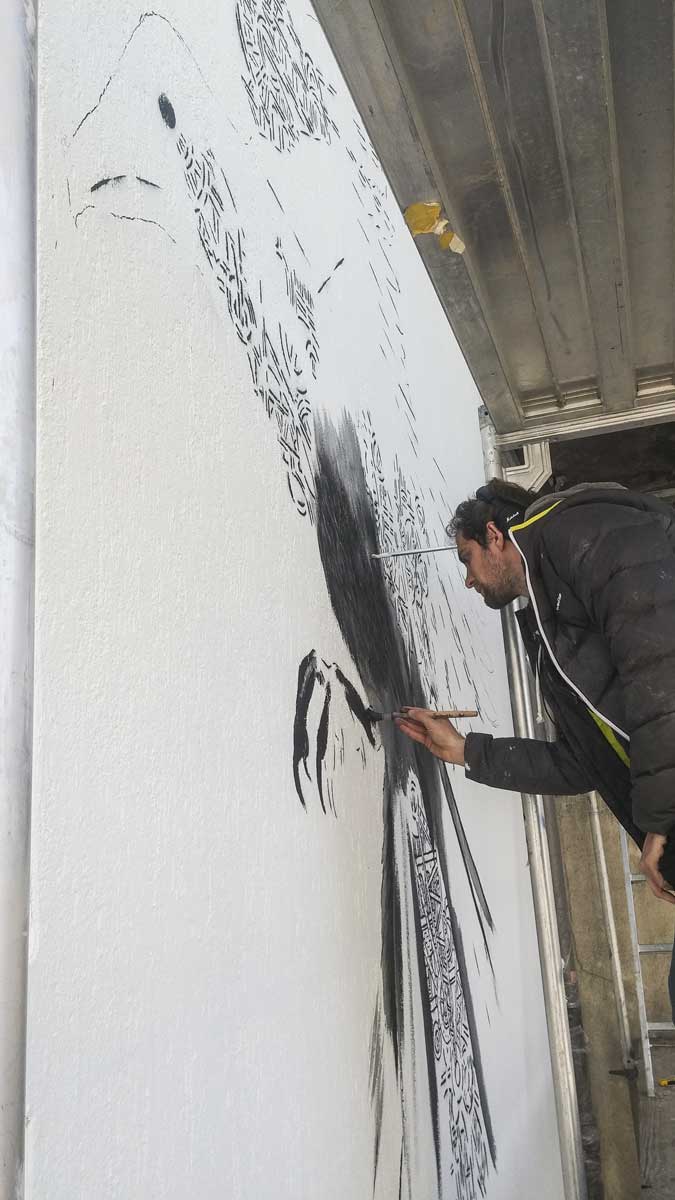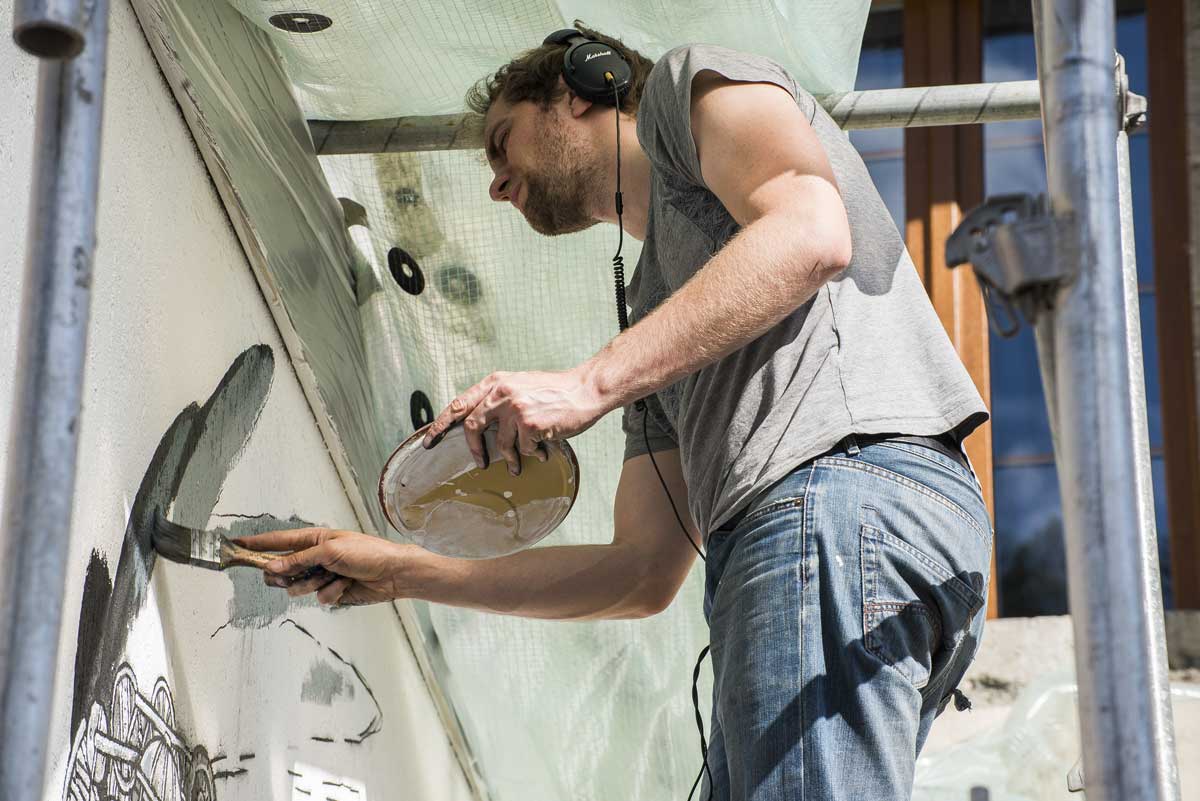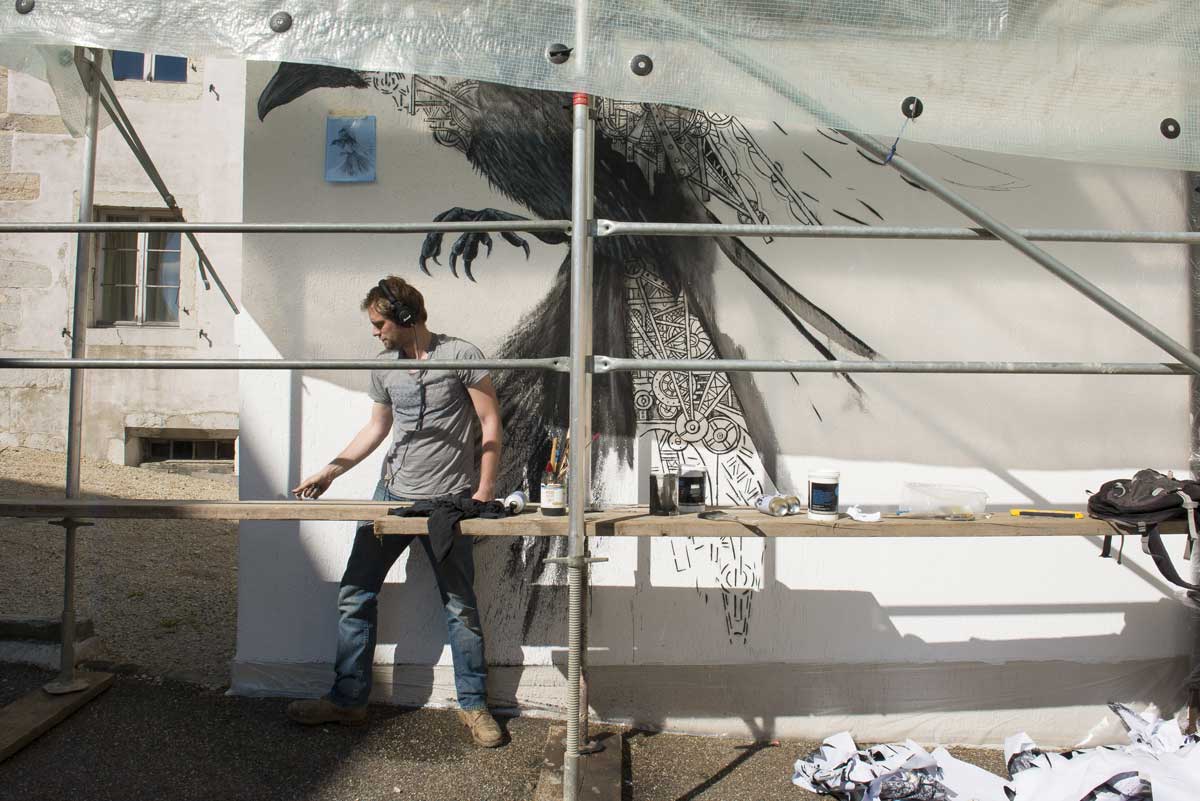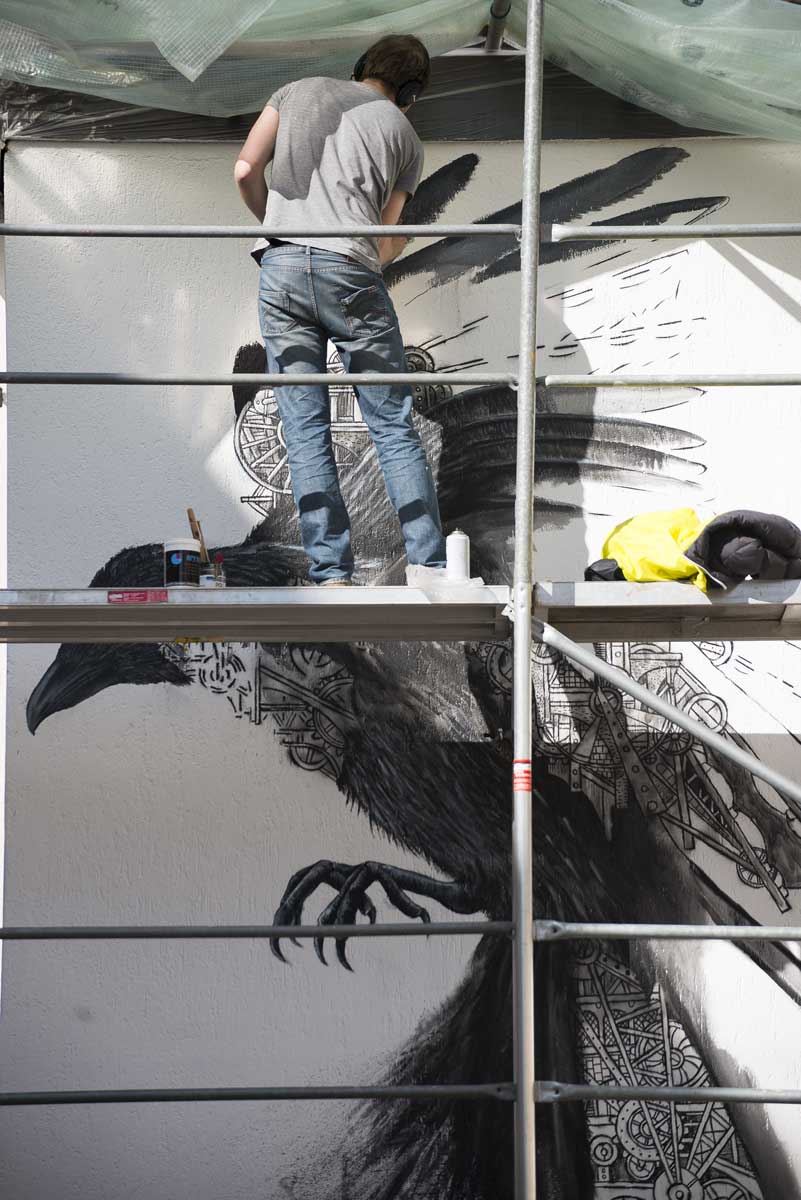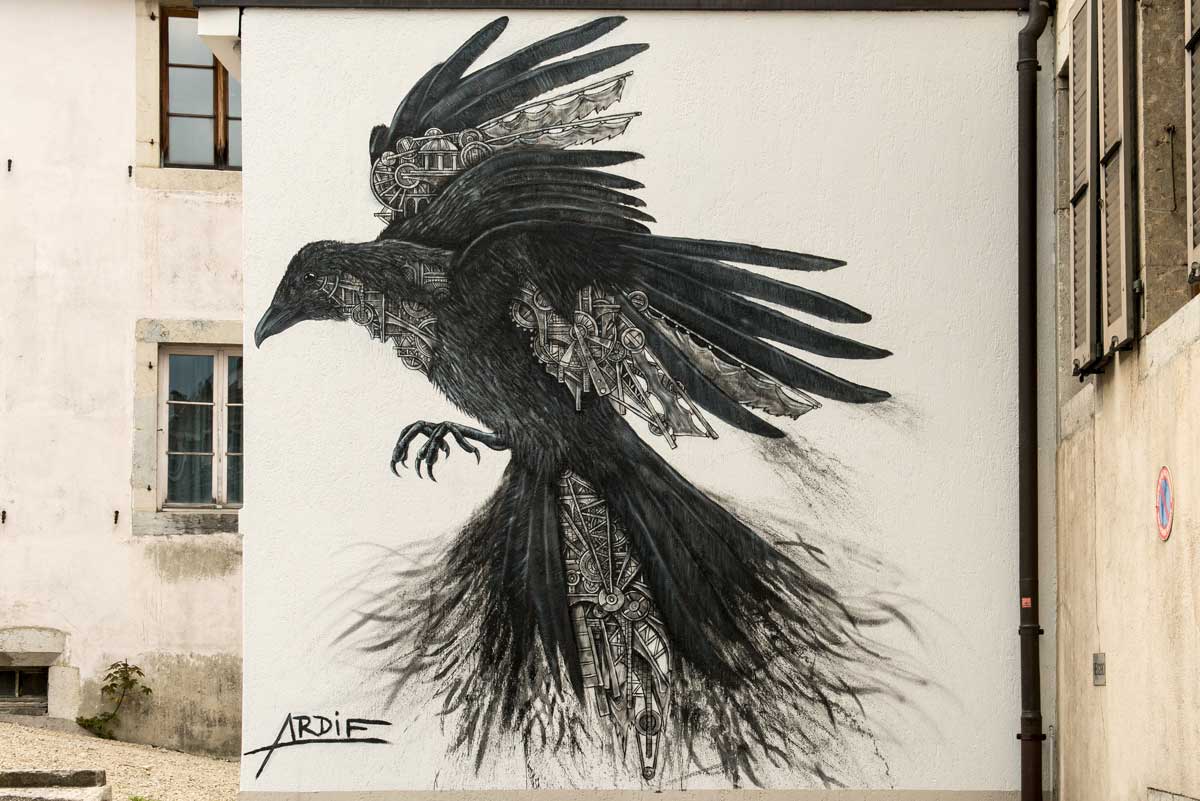Ardif
[FR]
- THE WORK -
Lead in the wings
TITLE: Du plomb dans l'aile [Lead in the wings]
Technique: STENCIL, SPRAY PAINTING, PAINTING
YEAR CREATED: 2019
LOCATION: Rue de la Gare
SURFACE AREA: 24 m2
An expert in collage, Ardif has achieved international recognition for the delicate, lace-like intricacy of his works and, more widely, the elegance of his graphic universe, a hybrid world in which nature and technology somehow have to be reconciled. His fascination for the mechanics of art and watchmaking made the artist the perfect person to enhance a “forgotten” wall of Maison DuBois, one of Switzerland’s first watchmaking factories (established in 1785). On this wall, which is particularly exposed to the elements, the artist used mineral paint for the first time to produce a work that would last longer than a paper collage. Sketched using stencils and finished with a brush, this is Ardif’s first mural.
From reptiles to birds by way of invertebrates and mammals, Ardif’s mechanical bestiary pays homage to animals from all over the world, some on the verge of extinction, some already gone or even on occasion imaginary. In Le Locle, the artist is honouring the carrion crow, a familiar bird in the countryside and increasingly in our towns and cities, but one that often arouses fear and terror because of its hoarse call and funereal black plumage. Unfortunately for the bird, it is often confused with the raven, the “bird of ill omen” according to lingering popular superstitions. In Ardif’s eyes, this corvine is a particular source of inspiration for the irrational fears it causes.
Symbolically, Ardif’s mural illustrates the increasingly porous dividing line separating the living from the lifeless, the organic from the inorganic. By painting a hybrid crow, is the artist offering us the depiction of a bird transformed into a cybernetic organism? Or is it “simply” a mechanical crow, in other words a feathered automaton? While Ardif’s retrofuturist aesthetic tilts the balance in favour of the second hypothesis, the first can’t be ruled out because today’s biotechnology is allowing animals to become cyborgs.
AN AUTOMATON DISGUISED AS A CROW
Feathers appear alongside leather and metal. Remiges are replaced with what looks like torn netting or the frayed sails of a windmill. Muscles and pistons are interlinked. Axles and cogwheels serve as joints. Inspired by steampunk or Jules Verne, the technology dreamt up by Ardif evokes the kind developed by François Junod, the contemporary Swiss automaton-maker who excels in the art of simulating the living through uniquely mechanical means, like his illustrious predecessors Jaquet Droz and François Lechot, mythical figures in traditional watchmaking craftsmanship that is so important to the region. Symbolically, Ardif’s retrofuturist aesthetic is a reminder that when it comes to science, “progress” and obsolescence are the two faces of Janus. [Janus is the Roman god of beginnings and endings, choices, change and doors. He has two faces: one turned to the past, the other to the future.]
The idea of automatons and autonomous robots sprang up very early in the human mind. In Greek mythology, Hephaestus, the god of fire, blacksmiths, metalworking and volcanoes, devised animated creatures, androids inspired by humans or animals, including an eagle made for Zeus.
The first flying automaton, a wooden pigeon powered by steam, is attributed to Archytas of Tarentum (435-347 BC).
In Alexandria, in around the 3rd and 2nd centuries BC, the first automatons of singing birds designed by the engineer Ctesibius (285-222 BC) chirped merrily away thanks to a system using hydraulic power.
More recently, the delicate mirror with a singing bird made by Frères Rochat in the early 19th century is considered one of the showpieces of the Watch Museum of Le Locle (MHL).
For creators of automatons, birdsong is much easier to imitate than the human voice. This is certainly one of the reasons why birds were – and still are – among their favourite animals.
DRONE BIRDS
Ardif’s mechanical crow invariably makes you think of a drone because these days some drones disguised as birds are astonishingly realistic. Unless you are an ornithologist, soon it’ll no longer be possible to distinguish between a bird and a drone created to look like one, especially if it is a top-of-the-range product such as the Robird made by Dutch firm The Drone Bird Company. This model, which very realistically imitates the flight of the peregrine falcon, is used to scare and chase away nuisance birds and monitor airport perimeters, the sites of oil and gas companies and large expanses of agricultural land. Robirds unobtrusively facilitate border control and the work of the police and special forces.
In 2015, the Chinese government set up a surveillance programme entitled “Dove” with the aim of furtively strengthening control of its population with drones resembling birds. As with Ardif’s crow, things aren’t looking too good for the dove, the symbol of peace.
CYBERNETIC ORGANISMS, ALIAS CYBORGS
And what if Ardif hadn’t painted an automaton in the form of a bird, but a crow of flesh and blood transformed into a cyborg by a fan of transanimalism? Today, turning a living animal into a cyborg is as easy as anything. Established in 2009, the start-up Backyard Brains sells – for the “modest” sum of 160 USD – a small kit allowing you to operate a cockroach and control its movements via a smartphone by means of an electronic device powered by a mini-battery fixed on the insect’s back… When will the same happen to birds?
CYBERPUNK METAPHOR
For lovers of science fiction, it’s easy to imagine Ardif’s crow being gnawed away at by a kind of mechanical scabies. A new form of virus transmitted by the machine to the animal. A mutation born of the unnatural marriage of the organic and inorganic. Metaphorically, an anomaly of this kind could symbolise science getting carried away, forging blindly ahead, driven by progress. The kind of dark vision that Philip K. Dick, H. R. Giger, Jodorowsky and other masters of science fiction might have had. “(…) I want people to be able to imagine a truly natural part in my drawings because this is what creates opposition and dialogue. People often perceive my work in a pessimistic way, like an abuse of progress. Others say that they’re robotic animals. All points of view are interesting, but for me they really are animal-inspired machine architectures,” stresses Ardif, before continuing: “I really like the idea that these creations open up people’s imaginations. Street art allows everyone to come up with their own interpretation.”
Rue de la Gare
- THE ARTIST -
ARDIF
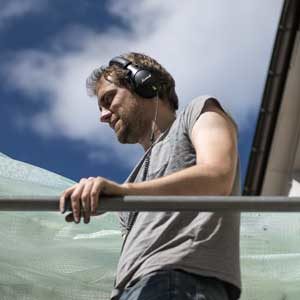
Ardif was born in Paris in 1986. After dropping out of studying maths, he took an art foundation course to learn about drawing and history of art. This made him aware of his interest in architecture, an art form he had avoided for fear of following in his father’s footsteps. Having got over his complex linked to the notion of legacy, he decided to become an architect himself. After graduating, he set up the collective Concrete Balloons with some architect friends. Their work consisted of creating phantasmagorias inspired by exploring industrial wasteland and old abandoned factories. Their collaboration led to an exhibition entitled “Imachinarium”. “My interest in somewhat chaotic structures comes from that time,” explains the artist. He then got the idea for his first mechanimal, a cat that was half feline, half machine. In the months that followed, Ardif created a whole set of mechanimals. Seeing animals as an inexhaustible source of inspiration, Ardif makes it a principle never to draw the same animal twice. The choice of depicting animals came from his desire to draw people into his imaginary world of machine architecture through figures they know and like.
Given the complexity of his drawings and the precision of his strokes, skills that come from industrial design, Ardif prefers to use stencils. He produces his works in his studio before sticking them in the street. His first collages, small formats, appeared in the streets of Paris in September 2016. Ardif likes the fragility of collages: “For me, the essence of street art remains its ephemeral character”.
His desire to express himself in the street obviously comes from his admiration for street art, but also for New Realists such as Villeglé who tore down posters to put them in museums. “My training as an architect had already led to me taking an interest in the city in order to shape it and give it a new face. However, as an artist, I could do the same thing in a less standardised and administrative way, more freely. I also wanted to participate in this great idea of art for everyone, accessible to passers-by whatever their class or environment. For me that’s what large-scale art should be.”
Influenced by land art, poster artists and giants such as Jules Verne, Hayao Miyazaki and Jean Tinguely, and fascinated by industrial design and steampunk, the artist often produces symmetrical works, showing complete duality, to challenge us about our relationship with nature and the way in which our insatiable quest for new technologies transforms it. “What interests me most about symmetry is the notion of balance. (…) If man hadn’t progressed, we’d still be in the Stone Age, but the technology created must be placed at the service of mankind without being at the expense of overexploiting nature or making our natural heritage artificial. Symmetry therefore also represents a kind of balance between these elements,” explains the artist. His animal incursions in the urban space are also invitations to reconnect with our wild, primitive instinct and animal life.
Ardif’s international career is flourishing with more collaborations, exhibitions and performances in European capitals as well as in smaller places like Le Locle.
To print the content of the page, please click on the printer icon.
- The exo -
on the web
Thank you for following and supporting the exomusée on Facebook, Instagram and YouTube!
